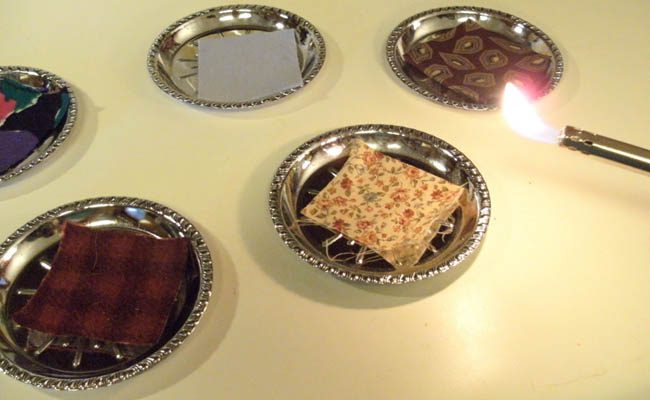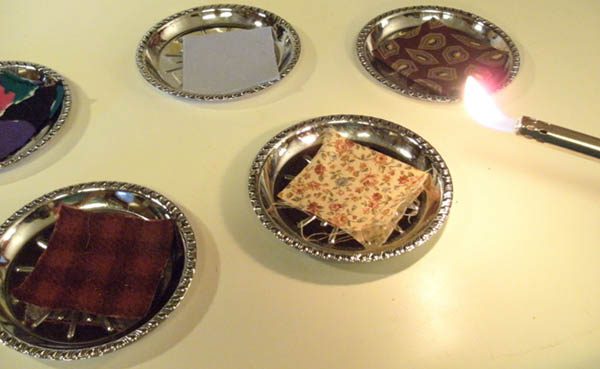
We’ve all been there- you see a gorgeous fabric that you need to have. But is it real silk or just a very high quality synthetic? Or maybe someone gifted you a giant stash of old fabrics and you want to know what they are. Today we’re going to teach you a surefire way to find out the fiber context of fabrics- something every designer should know how to do!

Knowing and understanding fabric content is crucial. You don’t want to present a design claiming it to be 100% wool and find out afterwards it’s acrylic. It is also important to know if you dye your own textiles, as different dyes are made to work on different fabrics (for example, the kind of dye used for cotton or linen cannot be used on wool).
Most fabric sellers are very helpful and knowledgeable and will be able to tell you the exact fiber content if you request it. However, if you are ever in a situation where you are unsure, this test will be a big help. Simple swatch the fabrics you’re interested in and perform the tes before purchasing.
The Burn Test, is exactly what it sounds like. Though we can usually guess what something might be by looking or touch, it’s impossible to be completely sure. However, every fabric burns differently, giving away its contents with accuracy.
Here’s how to do it: if you are in a store or ordering online, request a sample. Cut a small piece, about a 1-inch square. Next, find a well-ventilated area such as your studio or kitchen. Place your sample on a non-flammable surface; a clean ashtray works well.
Next, take a lighter and VERY CAREFULLY burn your sample. As it burns, observe what’s happening- what color is the flame, how does it smell, Does it melt, etc. Several reactions may be happening at once, so you may have to do the test a few times or get a friend to watch with you in order to note everything.
Finally, take a look at the chart we’ve provided and see what matches up. Print it out and keep it in your studio as a reference!
| Fabric | Class | Burning Characteristics | Odor | Residue |
| Cotton | Vegetable | Burns rapidly, clear flame, afterglow | Burning paper | Very little ash |
| Linen | Vegetable | Burns less rapidly than cotton | Burning paper | Light body ash in shape of cloth |
| Rayon | Semi-Synthetic | Burns less rapidly than cotton with slight melting, no afterglow | Burning paper | Soft black ash |
| Tencel | Vegetable | Continues burning after flame is removed, yellow flame | Burning wood | Grey ash |
| Silk | Animal | Burns slowly, shrinks from flame but does not melt | Burning hair or feathers | Small, brittle beads |
| Wool | Animal | Burns slowly, orange flame, shrinks from flame but does not melt | Burning hair or feathers | Large bead or ball, brittle, easily crushed |
| Nylon | Synthetic | Does not flame, seems to melt | Chemical odor | Hard bead, cannot be crushed |
| Acrylic | Synthetic | Flames and burns rapidly with hot, sputtering flame, black smoke | Fishy odor | Irregularly-shaped black bead |
| Polyester | Synthetic | Burns slowly, shrinks from flame giving off black smoke | Sweet chemical odor | Hard, cream-colored bead that becomes darker tan |
| Acetate | Synthetic | Flames and burns rapidly, double check by placing in nail polish remover- it will dissolve | Burning paper and hot vinegar | Hard, dark, solid bead |
Chart information is courtesy of Kiranada Sterling Benjamin (betsysterlingbenjamin.com) and pacificfabrics.com.

Najla Burt
Once again another great article! I’m definitely going to print out the chart as a reference.
Nicole Giordano
Excellent!